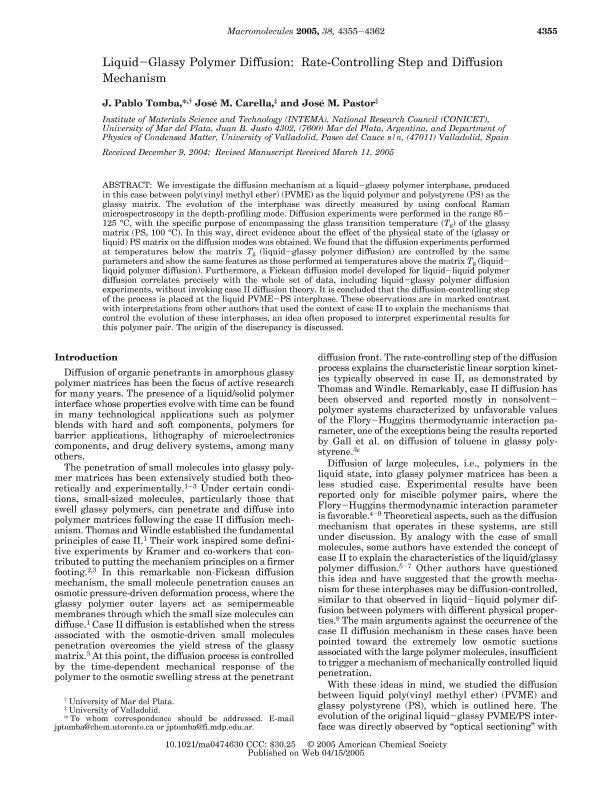Mostrar el registro sencillo del ítem
dc.contributor.author
Tomba, Juan Pablo

dc.contributor.author
Carella, Jose Maria

dc.contributor.author
Pastor, José. M.
dc.date.available
2019-12-27T06:56:45Z
dc.date.issued
2005-05-15
dc.identifier.citation
Tomba, Juan Pablo; Carella, Jose Maria; Pastor, José. M.; Liquid-Glassy Polymer Diffusion: Rate-Controlling Step and Diffusion Mechanism; American Chemical Society; Macromolecules; 38; 10; 15-5-2005; 4355-4362
dc.identifier.issn
0024-9297
dc.identifier.uri
http://hdl.handle.net/11336/93065
dc.description.abstract
We investigate the diffusion mechanism at a liquid-glassy polymer interphase, produced in this case between poly(vinyl methyl ether) (PVME) as the liquid polymer and polystyrene (PS) as the glassy matrix. The evolution of the interphase was directly measured by using confocal Raman microspectroscopy in the depth-profiling mode. Diffusion experiments were performed in the range 85125°C, with the specific purpose of encompassing the glass transition temperature (Tg) of the glassy matrix (PS, 100°C). In this way, direct evidence about the effect of the physical state of the (glassy or liquid) PS matrix on the diffusion modes was obtained. We found that the diffusion experiments performed at temperatures below the matrix Tg (liquid-glassy polymer diffusion) are controlled by the same parameters and show the same features as those performed at temperatures above the matrix T g (liquid-liquid polymer diffusion). Furthermore, a Fickean diffusion model developed for liquid-liquid polymer diffusion correlates precisely with the whole set of data, including liquid-glassy polymer diffusion experiments, without invoking case II diffusion theory. It is concluded that the diffusion-controlling step of the process is placed at the liquid PVME-PS interphase. These observations are in marked contrast with interpretations from other authors that used the context of case II to explain the mechanisms that control the evolution of these interphases, an idea often proposed to interpret experimental results for this polymer pair. The origin of the discrepancy is discussed.
dc.format
application/pdf
dc.language.iso
eng
dc.publisher
American Chemical Society

dc.rights
info:eu-repo/semantics/openAccess
dc.rights.uri
https://creativecommons.org/licenses/by-nc-sa/2.5/ar/
dc.subject.classification
Ingeniería Química

dc.subject.classification
Ingeniería Química

dc.subject.classification
INGENIERÍAS Y TECNOLOGÍAS

dc.title
Liquid-Glassy Polymer Diffusion: Rate-Controlling Step and Diffusion Mechanism
dc.type
info:eu-repo/semantics/article
dc.type
info:ar-repo/semantics/artículo
dc.type
info:eu-repo/semantics/publishedVersion
dc.date.updated
2019-08-27T18:47:12Z
dc.journal.volume
38
dc.journal.number
10
dc.journal.pagination
4355-4362
dc.journal.pais
Estados Unidos

dc.journal.ciudad
Nueva York
dc.description.fil
Fil: Tomba, Juan Pablo. Consejo Nacional de Investigaciones Científicas y Técnicas. Centro Científico Tecnológico Conicet - Mar del Plata. Instituto de Investigaciones en Ciencia y Tecnología de Materiales. Universidad Nacional de Mar del Plata. Facultad de Ingeniería. Instituto de Investigaciones en Ciencia y Tecnología de Materiales; Argentina
dc.description.fil
Fil: Carella, Jose Maria. Consejo Nacional de Investigaciones Científicas y Técnicas. Centro Científico Tecnológico Conicet - Mar del Plata. Instituto de Investigaciones en Ciencia y Tecnología de Materiales. Universidad Nacional de Mar del Plata. Facultad de Ingeniería. Instituto de Investigaciones en Ciencia y Tecnología de Materiales; Argentina
dc.description.fil
Fil: Pastor, José. M.. Universidad de Valladolid; España
dc.journal.title
Macromolecules

dc.relation.alternativeid
info:eu-repo/semantics/altIdentifier/url/https://pubs.acs.org/doi/10.1021/ma0474630
dc.relation.alternativeid
info:eu-repo/semantics/altIdentifier/doi/http://dx.doi.org/10.1021/ma0474630
Archivos asociados
